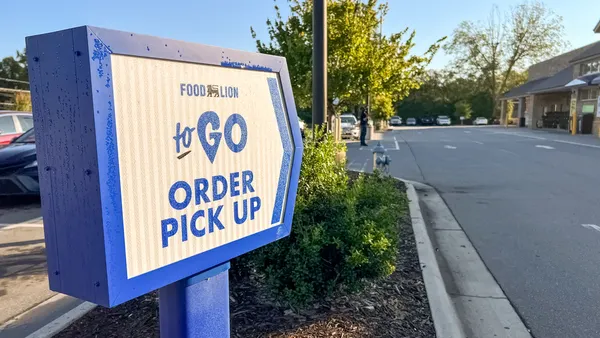Dive Brief:
- FMI and Nielsen have updated their predictions on online food and beverage sales to $143 billion by 2025, which will represent 30% of all omnichannel food and beverage spending, according to a report sent to Grocery Dive based on a presentation from FMI Midwinter. This figure was first predicted in 2017 as $100 billion by 2025 and updated last year to $100 billion reached between 2022 and 2024.
- Shoppers ages 45 to 64 represent the largest number of omnichannel households. Omnichannel spending for the group ages 44 to 64 specifically grew about $20 billion over the past two years — faster than younger generations.
- Gen Z shoppers spend about $550 per month on groceries and about 15% ($85) of that is spent online. Millennials spend more on groceries ($615) and about 26%, or $157 per month goes to online shopping. Value is most important for Gen Z and millennial shoppers when choosing a grocery store, followed by cleanliness, product selection and variety. Location is also a factor with 72% not willing to spend more than 20 minutes in travel.
Dive Insight:
For the second consecutive year, FMI and Nielsen are updating their predictions of online sales as consumer habits shift with new retailer offerings. The report attributes the higher numbers to a number of reasons, including an uptick in Amazon Prime members and auto replenishments, the increase of two hour delivery to homes, greater adoption of click-and-collect by retailers, meal kit deliveries, retail foodservice and shoppers switching how they buy certain items from in-store to online.
Despite the fact that many retailers typically target Gen Z shoppers, the report found the majority of online shoppers are older. Gen X and baby boomer's online shopping habits may be due to lack of mobility, transportation or feeling like they can take their time shopping digitally than in-store. With delivery and service fees decreasing recently, these demographics appear to be embracing online shopping more. This supports FMI’s 2019 findings that reach from online retailers was strong among Gen X shoppers, growing from 29% in 2018 to 40% a year later. A 2018 survey from the International Food and Information Council and AARP reported similar findings.
Gen Z shoppers, on the other hand, still prefer and enjoy in-store shopping, the research found. They want to be able to pick their own produce and discover new products. They like the in-store experience overall, which is why retailers continue to enhance the in-store experience by features like kombucha bars, beer gardens, food courts, games, classes and digital capabilities.
Even though projections for e-commerce are rising, the study also found that only 4% of retailer respondents consider themselves very sophisticated in the online market, meaning there’s a lot of room for progress and growth.
To win with omnichannel shoppers, FMI recommends retailers understand which shoppers are buying online vs in-store and how to personalize the pricing and assortment to the demographic based on location and store-type.
Other recommendations include optimizing technologies like AI, changing the physical store by putting an emphasis on fresh produce and foodservice, and bringing health and wellness initiatives to online shoppers. To increase frequency rather than just penetration, the report suggests retailers have low or no minimum purchase amounts and free shipping.













